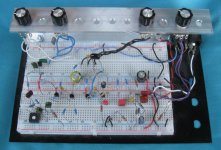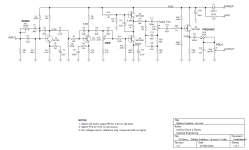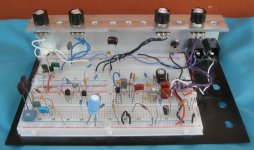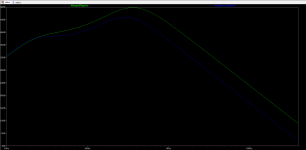Chuck D. Bones
Circuit Wizard
Holy Crap! This thing ROCKS!
I built it stock except I put a 250K trimpot in place R22 and connected pin 2 to C16. This is where the Treble pot would go in a Marshall tone stack. More than enough gain on tap. There is no clean setting unless you dial your guitar volume way down. Who wants to do that? So far, I've explored RANGE settings between 8:00 & 11:00. The only JFET selecting I did was I made sure that Q5 had a higher Idss than Q4. I used a BC109C for Q1. I'll try some mods and JFET subs tomorrow, but I'm pretty happy with stock circuit. It has a lot more gain than The Wizard. This circuit employs the relatively high drain-gate capacitance of the MPF4393 to roll-off the high end and smooth out the distortion. LTSpice tells me that the bass roll-off in the 1st stage coupled with the treble roll-off in the 3rd stage produces a broad mid peak around 500-600Hz and I think this is critical to getting that Tony Iommi tone. I expect other JFETs will sound different. More to come.
Of course the knobs had to be black!
L-R: VOL4, PRESENCE, GAIN, RANGE.
The treble trimpot is at the lower left.
See the two black jumpers and the 470Ω resistor below the two red WIMA caps? That's my Idss test jig.

I built it stock except I put a 250K trimpot in place R22 and connected pin 2 to C16. This is where the Treble pot would go in a Marshall tone stack. More than enough gain on tap. There is no clean setting unless you dial your guitar volume way down. Who wants to do that? So far, I've explored RANGE settings between 8:00 & 11:00. The only JFET selecting I did was I made sure that Q5 had a higher Idss than Q4. I used a BC109C for Q1. I'll try some mods and JFET subs tomorrow, but I'm pretty happy with stock circuit. It has a lot more gain than The Wizard. This circuit employs the relatively high drain-gate capacitance of the MPF4393 to roll-off the high end and smooth out the distortion. LTSpice tells me that the bass roll-off in the 1st stage coupled with the treble roll-off in the 3rd stage produces a broad mid peak around 500-600Hz and I think this is critical to getting that Tony Iommi tone. I expect other JFETs will sound different. More to come.
Of course the knobs had to be black!
L-R: VOL4, PRESENCE, GAIN, RANGE.
The treble trimpot is at the lower left.
See the two black jumpers and the 470Ω resistor below the two red WIMA caps? That's my Idss test jig.

Last edited:





